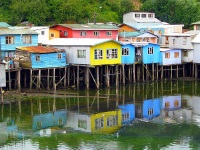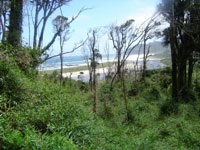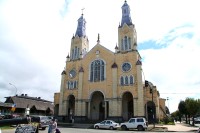
Castro is the main town (technically a city) on Chiloé Island. It is actually the third oldest city in Chile, founded in 1576. Castro is famous for its colourful rows of palafitos (stilted houses) lining the estuaries, excellent seafood and traditional handicrafts. With an eclectic blend of Chilote culture and modern development, Castro is a popular summer destination for Chilean and Argentinean tourists and has a laid back feel to it.One of the town's most interesting features is the San Francisco Church, painted in dazzling pastel colours. The town itself is full of interesting features however, including craft markets, the regional museum, and the MAM Gallery. There are a range of restaurants and shops, and a few bars to keep the fun going at night. The central town square, Plaza de Armas, is the heart of Castro and here you will find a number of great places to eat, as well as a prime people-watching position.Cycling around the island is a popular activity and a good way to see the sights. The town also provides access to the nearby islands of the Chiloé archipelago and the Parque Nacional Chiloé, which make for wonderful excursions.

Following in the footsteps of Darwin after 150 years, visitors will find an isolated but wildly beautiful assortment of rolling hills, native forests and pristine coastline in Parque Nacional Chiloé. It is home to the Chilote fox, the rare pudú (miniature deer) and over 100 species of birds, including the Magellanic penguin. The park offers a variety of walking trails, through forests and under twisted tepú trees, along miles of unspoilt coastline or along nature trails that lead up onto the hills for superb views of the surrounds. One of the draws of the hiking trails in Chiloé is the wide selection of short hikes, making it a good activity even for visitors who aren't in the best shape. There are also epic hikes for those who want to walk long-distances. The park is home to several Huilliche Indian communities.The information centre at the entrance has good displays on the flora, fauna and the traditions and folklore of the Huilliche people. This amazing wilderness area is only 18 miles (30km) west of Chonchi and 34 miles (54km) west of Castro, making it easily accessible. The area receives a huge amount of rain year round so be sure to dress appropriately.
Website : www.parquechiloe.cl

The Spanish, who arrived in the 16th century, and Jesuit missionaries that came to Isla Grande de Chiloe in the 17th century, built hundreds of wooden churches in the archipelago in an attempt to 'civilise' the three local Indian tribes that occupied the islands. The Jesuits built more than 80 of these places of worship, and the Franciscan order later joined them and added to the region's astounding collection of chapels and churches. The 16 churches which still remain well-preserved have been jointly UNESCO-listed. Visiting some of these old buildings is one of the most interesting things to see and do in Isla Grande de Chiloe.Apart from being very old, the churches have a unique architecture which makes them special; in fact, the whole archipelago benefits from its own style of building which visitors find delightful. Although recognisably colonial in some ways the mix between the local and the European is unexpected and original to the area, possibly because isolation allowed the architectural style to develop largely undisturbed for centuries. The churches are wooden, often painted with the pastel colours associated with Castro. Three of the most famous can be found in the villages of Chonchi and Dalcahue, and in Castro itself.The churches are a popular tourist attraction in Isla Grande de Chiloe and for those lucky enough to travel to this region should try to visit as many as possible.

Travel Guide powered by Word Travels, copyright © 2023 Globe Media Ltd. By its very nature information in this travel guide is subject to change at short notice and travellers are urged to verify information on which they're relying with the relevant authorities. Neither Globe Media Ltd nor Travel Vogue can accept any responsibility for any loss or inconvenience to any person as a result of information contained above.